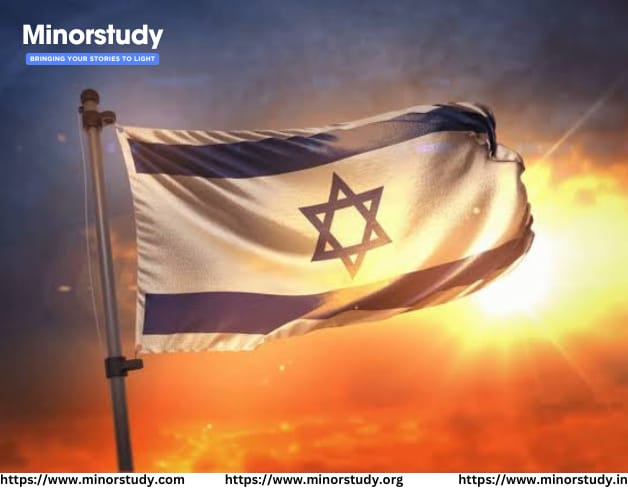🕊️ Introduction: More Than Stripes and a Star
The Israel flag — with its iconic blue stripes and central Star of David — is not just a national symbol; it’s a profound emblem of identity, faith, resilience, and controversy. From its roots in Zionist symbolism to its adoption at statehood, the flag has woven itself into the cultural, political, and emotional landscape of Israel and global Jewish communities.
Let’s unravel its story — and why this piece of cloth stirs both the deepest pride and heated debate.
🏛️ History & Origins
The design stems from 19th-century Zionist aspirations, drawing deep inspiration from the tallit, the traditional Jewish prayer shawl. White background with blue stripes—these were first incorporated in symbols like the Rishon LeZion village flag (1885) and the B’nai Zion Society banner (1891) aish.com+3touristisrael.com+3youtube.com+3blog.judaicawebstore.com+13en.wikipedia.org+13thechurchoftheholysepulchre.com+13flagstudio.co.uk.
The Star of David (Magen David), while not uniquely Jewish at first, gained wide popularity as a symbol of Jewish identity in medieval Europe, becoming central to Zionist imagery by the late 1800s israel-travel-secrets.com.
In 1897, during the First Zionist Congress in Basel, David Wolffsohn declared the tallit-inspired flag a unifying emblem touristisrael.com+4aardvarkisrael.com+4thechurchoftheholysepulchre.com+4.
Though alternative designs were proposed during the early statehood period, the original Zionist flag was officially adopted as Israel’s national flag on October 28, 1948 en.wikipedia.org+12britannica.com+12myjewishlearning.com+12.
📆 Timeline at a Glance
| Year | Event |
|---|---|
| 1885 | Blue-white flag flown at Rishon LeZion agricultural settlement aardvarkisrael.com+1en.wikipedia.org+1. |
| 1891 | Zionist and communal flags with Star of David adopted in B’nai Zion societies . |
| 1897 | Zionist Congress in Basel embraces tallit-inspired design . |
| 1948-05-14 | Israel declares independence, raising Zionist flag . |
| 1948-10-28 | Flag legally adopted; raised over Knesset . |
| 1996 | Original ‘Ink Flag’ memorialized in Eilat — made under fire at 1948 Eilat capture . |
🌟 9 Powerful Facts About the Israel Flag
Based on a Prayer Shawl
Blue stripes mirror the tallit’s sacred design. The shade “techelet” connects back to scripture, symbolizing heavenly thought and mitzvot blog.judaicawebstore.com+10jewishvirtuallibrary.org+10britannica.com+10en.wikipedia.org+11thechurchoftheholysepulchre.com+11jewishvirtuallibrary.org+11.Star of David as Identity
The Magen David became Jewish symbol–over centuries adopted into flags, synagogues, and national heraldry flagstudio.co.uk+4myjewishlearning.com+4touristisrael.com+4touristisrael.com+5jewishvirtuallibrary.org+5thechurchoftheholysepulchre.com+5.Poetic Validation
Ludwig August Frankl’s 1864 poem “Judah’s Colors” praised blue and white as emblematic of Jewish identity israel-travel-secrets.com+9jewishvirtuallibrary.org+9myjewishlearning.com+9.From Zionism to Statehood
Used by early settlements and Zionist organs, it became Israel’s national flag just months after independence britannica.com+1thechurchoftheholysepulchre.com+1.Avoiding “Dual Loyalty”
Debates emerged post-independence about symbolic ties to Zionist movement. After review, the Zionist flag stood as national symbol jewishvirtuallibrary.org.Ink Flag Legacy
Under enemy fire in 1948, soldiers improvised the first Israeli flag in Eilat — now commemorated as a national symbol en.wikipedia.org.Unspecified Shade
Israeli law doesn’t lock in a precise blue—but a darker hue is suggested due to sun exposure britannica.com.Highest-Frequency Waving
Prominently displayed during Yom Ha’atzmaut (Independence Day), memorial ceremonies, international sports, and cultural events en.wikipedia.org+1thechurchoftheholysepulchre.com+1.Controversial Symbol
While a source of pride for many, it’s also contentious in protests and regional conflicts — seen as symbol of nationalism by some and oppression by others .
🛐 Symbolic Significance
Religious & Ritual: White for purity, blue for divinity and adherence to Torah precepts jewishvirtuallibrary.org.
Unity: A unifying emblem across Jewish diaspora and Israeli society.
Resilience & Rebirth: The Star of David represents Jewish unity and after centuries of hardship, rebirth of national identity.
National Identity: From official ceremonies to everyday life, it acts as visual representation of Israel’s existence.
🌍 Daily Life & Societal Impact
Cultural Presence: T-shirts, bumper stickers, jewelry—all showcasing cultural affiliation.
Education & Identity: Israeli students learn the flag’s evolution in schools, fostering civic pride.
Civic Rituals: Flown at half-staff on Yom HaZikaron (Memorial Day); cheers at Yom Ha’atzmaut events.
Global Diplomacy: Central at embassies, UN missions, international sports, and solidarity rallies.
Political Catalyst: Can trigger protests, particularly in solidarity marches or Palestinian-Israeli conflict contexts.
✍️ FAQs About the Israel Flag
Q1: What do the colors mean?
Blue stripes reflect the prayer shawl (tallit); white for purity; Star of David for Jewish identity thechurchoftheholysepulchre.comflagstudio.co.uk+6touristisrael.com+6touristisrael.com+6.
Q2: When was it officially adopted?
Adopted on October 28, 1948, months after Israel declared independence on May 14, 1948 colonialflag.com+1thechurchoftheholysepulchre.com+1.
Q3: Why two stripes?
Mirrors stripes on tallit; symbolic of guidance by Torah precepts colonialflag.com+3jewishvirtuallibrary.org+3myjewishlearning.com+3.
Q4: Is the blue shade fixed?
No, but darker blue is preferred for visibility under sun .
Q5: What’s the Ink Flag?
An improvised flag raised in Eilat during the 1948 War; now commemorated as a symbol of resourcefulness and unity touristisrael.com+10en.wikipedia.org+10independence-bunting.com+10.
💐 Wishing & Reflection
“May the stripes of the Israel flag guide us toward unity, while the Star of David illuminates our path to peace and resilience.”
“As the flag waves on Independence Day, may its message of hope and continuity echo through generations.”
Whether raising it in celebration or reflecting with it in remembrance, its presence elicits a deep emotional echo across both Israelis and global Jews.
📌 Key Takeaways
The flag reflects religious symbolism (tallit, techelet) and Jewish identity (Star of David).
From early Zionist banners to state flag, it’s a bridge between past and present.
A national flag since 1948, formally adopted on October 28.
Commemorated through half-staff days, ceremonies, and international representation.
Impacts daily life — in education, culture, diplomacy, protest, and unity.
Controversial symbolism makes it a potent global and political icon.
🧭 Conclusion: A Flag of Pride — and of Debate
The Israel flag is more than cloth — it’s a living canvas of history, spirituality, identity, and conflict. Its blue and white palette houses centuries of devotion, dreams, struggles, and sovereignty.
It stands as both:
A Powerful emblem of Jewish unity and statehood,
And a Controversial banner in wider geopolitical narratives.
In your daily life, encountering the flag—whether in Israel or abroad—reminds us of the complex tapestry behind this symbol. It teaches us about persistence, remembrance, cultural belonging, and the bittersweet weight of national identity.








